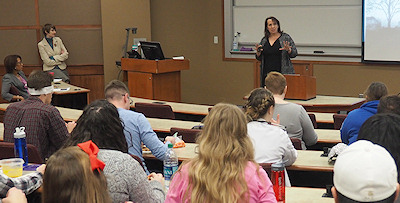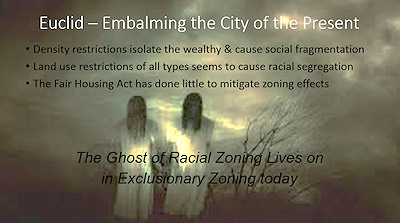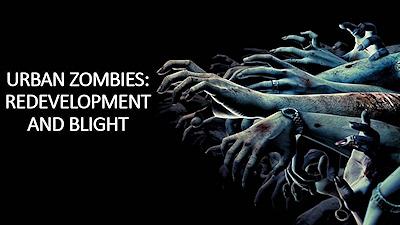The Scary Truth about Housing Segregation
 "Housing patterns and opportunities in this country are not just informed by modern laws, but are in a very real sense tormented by the grasping hand of the un-dead racism of the past." This was the message conveyed to law students in a "haunted housing" Halloween special edition Lunch and Learn sponsored by the Business and Transactional Law Center on October 31, 2017. Professors Andrea Boyack, Michelle Ewert, and Janet Thompson Jackson explained how "Ghosts, Witches, Zombies, Skeletons, Spiders, and Goblins still roam free in U.S. Housing Law, bringing instability and inequity to America's residential landscape."
"Housing patterns and opportunities in this country are not just informed by modern laws, but are in a very real sense tormented by the grasping hand of the un-dead racism of the past." This was the message conveyed to law students in a "haunted housing" Halloween special edition Lunch and Learn sponsored by the Business and Transactional Law Center on October 31, 2017. Professors Andrea Boyack, Michelle Ewert, and Janet Thompson Jackson explained how "Ghosts, Witches, Zombies, Skeletons, Spiders, and Goblins still roam free in U.S. Housing Law, bringing instability and inequity to America's residential landscape."
Ghosts: Professor Boyack began by explaining the rise in the late 1800s of race-based housing ordinances that expelled or excluded persons of color from neighborhoods that were majority white-occupied. She recounted how, to protect an owner's right to sell his property to the buyer he chose, the Supreme Court struck down explicitly racial zoning laws in 1917, but then warned that the "ghost of racial zoning" continues to haunt our land use and housing systems in the form of Euclidian zoning. Euclidian zoning is a tool of urban planning that restricts and separates land uses.  Even though residency in an apartment and a single-family home is the same use of property - namely residential use - Euclidian zoning treats these housing types as different uses. Such "use-based" separations become income-based separations and, together with other zoning tools such as minimum lot sizes, such land use laws tend to exacerbate racial segregation by isolating the wealthy and furthering social fragmentation.
Even though residency in an apartment and a single-family home is the same use of property - namely residential use - Euclidian zoning treats these housing types as different uses. Such "use-based" separations become income-based separations and, together with other zoning tools such as minimum lot sizes, such land use laws tend to exacerbate racial segregation by isolating the wealthy and furthering social fragmentation.
Witches: Professor Ewert spoke to students about the "spell cast by the witches" who enacted racially restrictive covenants in common interest communities throughout the nation, particularly after the demise of explicitly race-based zoning ordinances. Private covenants that ran with the land became ubiquitous in the first half of the 20th century, restricting occupancy in certain neighborhoods to people of the "white race." After public law restrictions based on race were disallowed, community covenants allowed a neighborhood to still exclude by race, albeit in an ostensibly more privatized way. The Supreme Court eventually held it unconstitutional to enforce racially restrictive covenants in court; however, the court did not hold racially restrictive covenants themselves to be a constitutional violation. That did not happen until the Fair Housing Act, at which time, the base residential geography of the country had been established. Exclusive community covenants remain in force if they are not based on race, and these communities tend to be bastions of residential segregation in many parts of the country.
Zombies: Professor Jackson educated students on the great migration and urban renewal in the 1920s to the 1950s. She explained people migrated from the South to the North because of belief there was less racism and more economic opportunity. As African Americans moved into urban areas, however, white residents either developed ways to exclude them or moved out. The development of the suburbs is tied directly to residential segregation desires and demands.  White flight to the suburbs eventually caused urban areas became pockets of poverty where there was, and still is, an endless cycle insufficient of resources. In the name of "urban renewal" (called at the time "negro removal"), urban cores were often subjected to development projects, using eminent domain to achieve these projects even against the landowners' will. The Supreme Court in Berman upheld local takings authority if it was part of a plan to "fight blight." This led municipalities to create an expanded definition of blight that allowed them to bulldoze and break up communities of color in the name of either preventing a "disease" that "threatened to turn healthy areas into slums" or even as a way to put an area to "a more productive use." Highway, stadium, and other urban renewal projects devastated communities, leaving unsustainable pockets of poverty (zombies). The effect of abusive eminent domain is still felt in the un-dead impoverished pockets of poverty ("urban zombies") today.
White flight to the suburbs eventually caused urban areas became pockets of poverty where there was, and still is, an endless cycle insufficient of resources. In the name of "urban renewal" (called at the time "negro removal"), urban cores were often subjected to development projects, using eminent domain to achieve these projects even against the landowners' will. The Supreme Court in Berman upheld local takings authority if it was part of a plan to "fight blight." This led municipalities to create an expanded definition of blight that allowed them to bulldoze and break up communities of color in the name of either preventing a "disease" that "threatened to turn healthy areas into slums" or even as a way to put an area to "a more productive use." Highway, stadium, and other urban renewal projects devastated communities, leaving unsustainable pockets of poverty (zombies). The effect of abusive eminent domain is still felt in the un-dead impoverished pockets of poverty ("urban zombies") today.
Skeletons: Professor Jackson explained that when poverty is concentrated, property values are decimated, and community cohesiveness is destroyed, the necessary consequence is a lack of local funding for schools. In a very real sense, then, housing policy is school policy. If a community is stripped of its resources and wealth, only the bare bones of the community are left to attempt to finance and support neighborhood schools. Although over 50 years ago, Brown v. Board of Education of Topeka held that children should attend integrated schools, schools today are more segregated than ever, due to the common neighborhood/property tax funding approach taken across the country and due to the narrow interpretation of Brown's integration mandate. When busing and affirmative desegregation of communities became politically unpopular, school vitality turned on a neighborhood's economic capacity. Because of this, children today still mostly attend segregated schools and are raised in communities where they are mostly exposed to people of their own race. School segregation creates and exacerbates other social problems.
Spiders and their Webs: Professor Boyack further educated students regarding the role that the federal government has long played in the mortgage capital market. Under New Deal policies to promote homeownership, the federal government funneled capital into the mortgage market, creating new opportunities for ownership. These opportunities were limited to homeowners in white neighborhoods, however. The federal government as a mortgage capital provider, set underwriting standards for mortgage loans, and determined that property values were adversely impacted when a neighborhood became more diverse. The federal Home Owners Loan Corporation created maps that "redlined" minority and diverse neighborhoods, and the Federal Housing Administration explicitly provided that lending in redlined areas was not to be considered prudent. Accordingly, communities of color were denied mortgage capital, making it vastly more difficult for non-white households to own their homes and making homes in non-white communities vastly less valuable. (In fact, racially restrictive covenants were based on sample language promulgated by the Federal Housing Administration itself, as a tool to keep property values high by keeping non-white would-be residents out.) The effects of redlining lasted long beyond their invalidation under the Fair Housing Act. In fact, the history in communities of color of being denied mortgage capital set the trap that allowed the "spider financiers" in the 1990s and 2000s to ensnare many homeowners of color in their "web of predatory lending." Empirical studies and anecdotal evidence strongly suggest that, during the housing boom, lenders specifically targeted minorities and minority communities for risky, expensive loans that were more likely to default and have higher interest rates. Predatory lending led to home loss, destruction of wealth, and property value devastation in communities of color.
Goblins: The parade of horribles finished up with Professor Ewert speaking about environmental racism. First, Professor Ewert cited some shocking statistics about the placement of industrial plants, waste treatment facilities, and other noxious but necessary community uses of land. To illustrate the associated harm, Professor Ewart used Altgeld Gardens in Chicago as a case study. Altgeld Gardens is a low-income housing community completely surrounded by factories - commonly referred to as "the toxic donut." People living in this community are often impoverished minorities and have long suffered significantly higher rates of cancer and birth defects, likely caused by the community's toxic air and polluted water.
But what can we as law students do? The presenting professors explained that, as future lawyers, Washburn Law students can help bringing stability and equity to America's residential landscape by being board members for housing developments in our communities and by taking on pro bono cases for those not normally able to challenge such issues due legal costs. We can help highlight the inequities in housing law and push for more equitable land use decisions and policies in the future. Lawyers have a voice in our legal and political system, and it is our responsibility to use our voice to help promote justice.